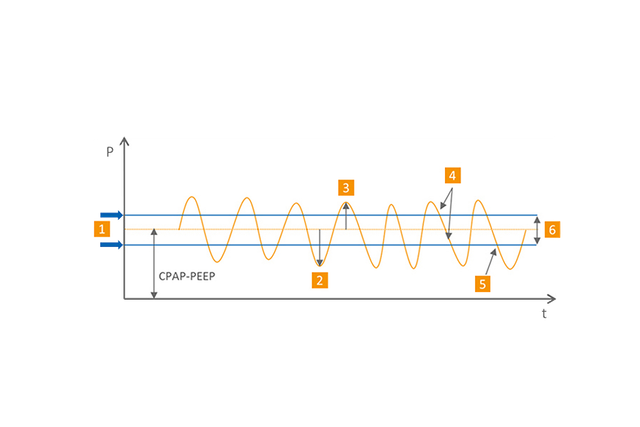Además de la CPAP convencional, son cada vez más los modos utilizados en el soporte respiratorio no invasivo (NRS: soporte nasal respiratorio) de pacientes neonatos a los que es necesario aplicar distintos niveles de presión.
Los modos sincronizados y los modos de disparo tienen una función especial en este grupo de modos denominados BiLevel. Los bebés prematuros y recién nacidos que respiran espontáneamente pueden lograr grandes resultados con el soporte respiratorio sincronizado y la detección automática de apneas.
Los sistemas de disparo convencionales requieren el uso de un sensor adicional, como una cápsula abdominal o un sensor de flujo. Mientras que la cápsula abdominal tiene efectos negativos en la piel tan sensible de estos pequeños pacientes, es difícil de colocar y presenta deficiencias a la hora de transmitir las señales respiratorias, los sensores de flujo dependen de las fugas y son más difíciles de colocar debido a tu tamaño y su peso.
MediTRIG funciona sin necesidad de sensores adicionales. Esto es posible gracias a la combinación del sistema de medición de la presión único del generador Medijet y el procesamiento de estas señales en los dispositivos nCPAP de medin. MediTRIG detecta tanto los episodios de apnea central como obstructiva.

1. Umbral de disparo superior e inferior
2. Ciclo de presión: inspiración
3. Ciclo de presión: espiración
4. La curva de presión alcanza el umbral de disparo superior e inferior: detección de la respiración espontánea (función de apnea)
5. La curva de presión alcanza el umbral de disparo inferior: detección de la inspiración (sincronización)
6. Sensibilidad de disparo dentro de un margen de +/- mbar en relación con al valor de PEEP
Las diferencias de presión fisiológica en la inspiración y la espiración se detectan en el generador Medijet y se miden en el dispositivo CPAP. Los umbrales de disparo se pueden ajustar individualmente y se almacenan en la curva de presión mostrada en la pantalla del dispositivo. Los dos umbrales de disparo se configuran como valores de presión positiva y negativa, en relación con el valor de PEEP como punto de referencia.
Si el paciente respira y las señales de presión en las vías aéreas durante la inspiración y la espiración alcanzan los umbrales de disparo, el dispositivo detecta la respiración del propio paciente. Si el paciente no respira por sí solo, las señales de presión de las vías aéreas ya no alcanzarán los umbrales de disparo. El dispositivo detecta la pausa respiratoria, por ejemplo, para iniciar las mediciones automáticas en los modos ApneaCPAP y SNIPPV.
MediTRIG no solo detecta las pausas respiratorias. Cuando se activa el umbral de disparo inferior, esta función detecta el inicio de la inspiración, lo que habilita la presión de soporte sincronizada en el modo SNIPPV.